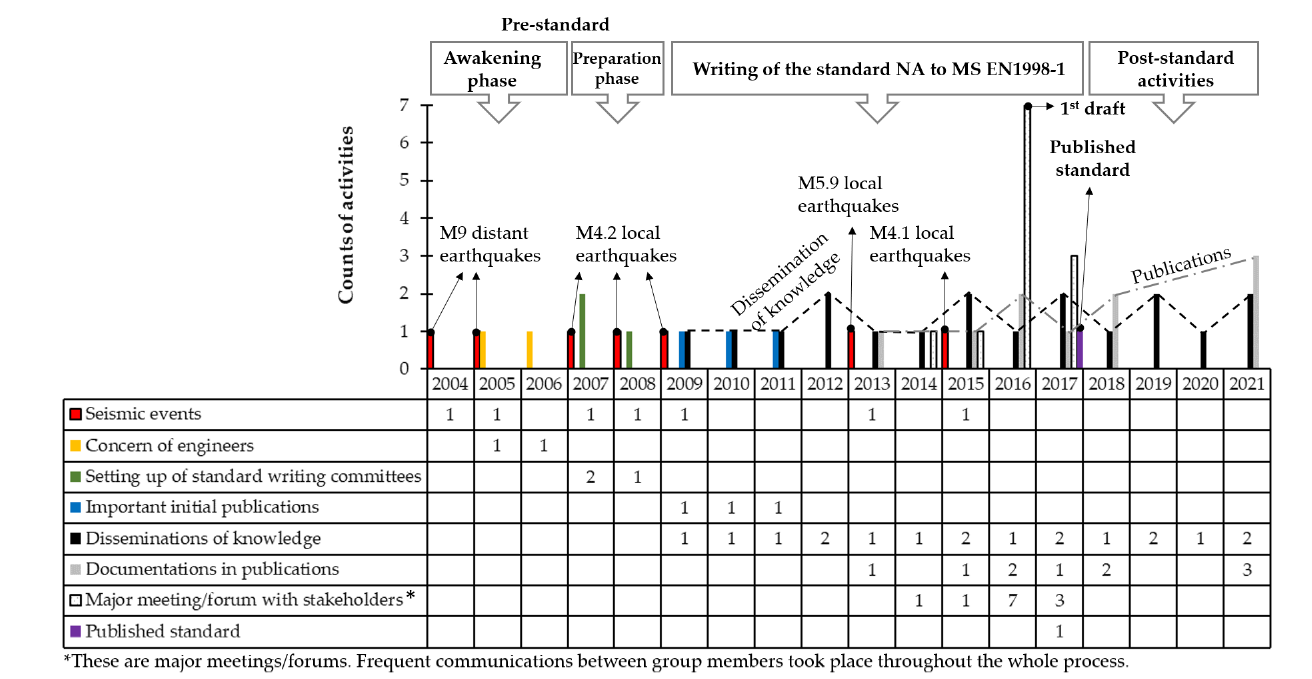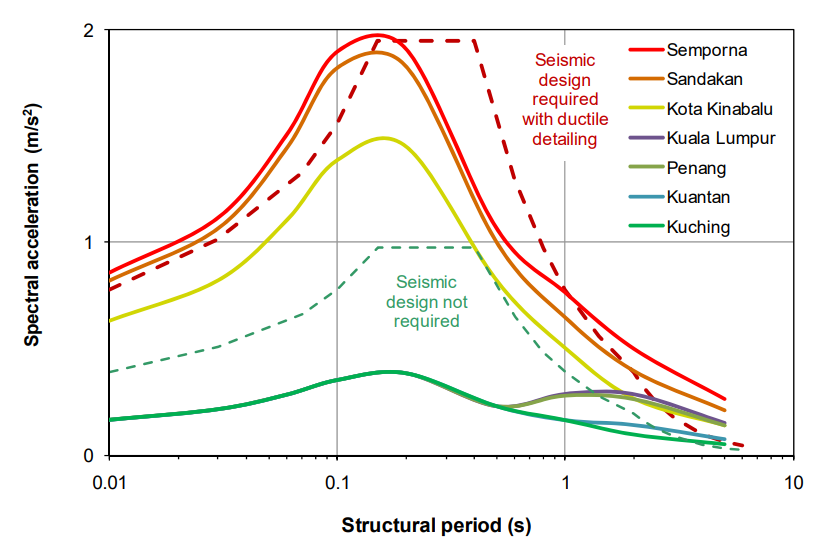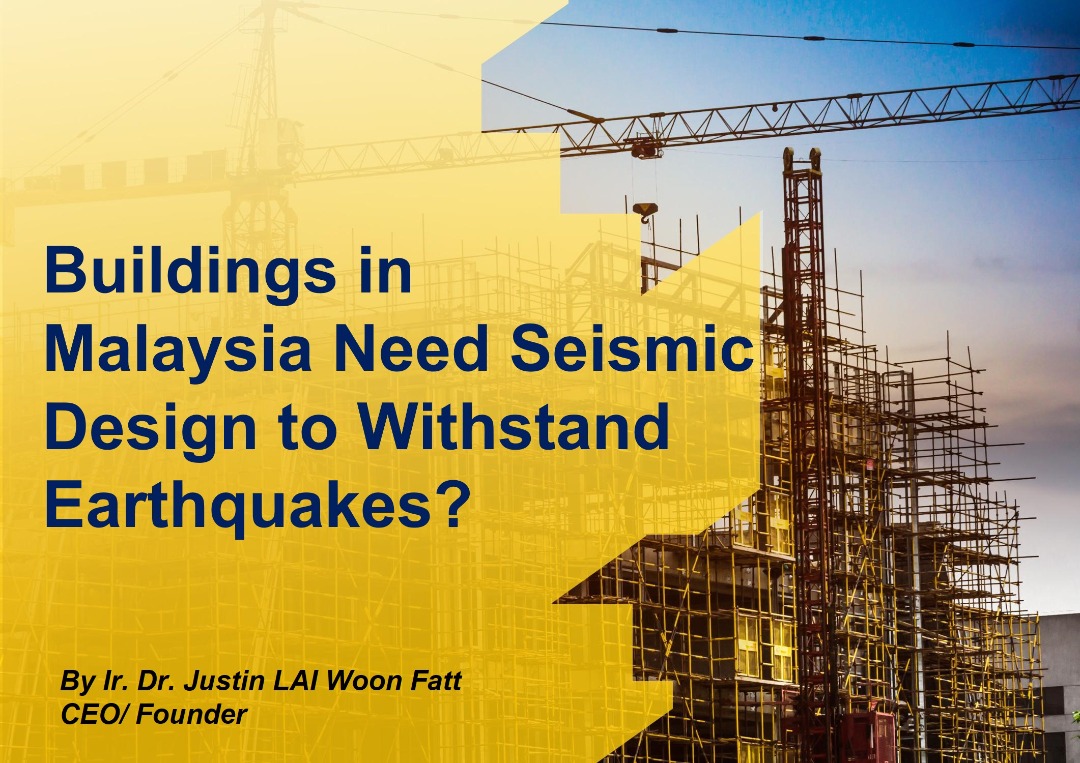Author: Ir. Dr. Justin LAI Woon Fatt | 5 March, 2022
Earthquake is one of the most devastating natural disasters throughout human history that affects the economy and livelihood of the people involved. The resulting ground motion can damage buildings, bridges, and infrastructures to various extents, in the worst-case scenario, structural collapse may occur and lead to mass fatalities [1]. One of the best modern examples would be the 2008 Sichuan earthquake that caused the collapse of over 7,000 schoolrooms that led to the death of nearly 5,000 students. The fundamental cause of these collapses was due to improper design of buildings to resist the expected earthquake loads [2]. Although Malaysia is not located at the Pacific Ring of Fire where earthquakes and other catastrophic events are most likely to take place, it is however surrounded by seismically active zones that pose risks of natural hazards to Malaysia.
Over the years, earthquake tremors in varying degrees had occurred in Malaysia. The most recent one was on 25th February 2022, it originated from a 6.2 magnitude earthquake from Bukittinggi, Indonesia’s West Sumatra province and the tremor felt in Selangor, Perak, Negeri Sembilan, Melaka, and Johor. The witnesses said that they had seen the doors, chairs, and objects on wall shaking. There were also reports claiming that several office buildings were evacuated for occupant safety. Fortunately, the quake had not raised tsunami threat to Malaysia and no injury/fatality has been reported [3]. However, the 2015 Sabah earthquake that occurred a few years ago in Ranau, Sabah had caused tragic events in Malaysia. A total of 18 causalities were reported from Mount Kinabalu [4]. As the epicenter of the earthquake was very close to Mount Kinabalu, the massive shaking had resulted in landslides all around the mountain. Some infrastructures were damaged during the earthquake, with around 23 schools affected, and Ranau Mosque was also damaged due to the tremor [5][6]. Hostels and resthouses located near the summit of Mount Kinabalu were also heavily damaged [7].
The Indian Ocean earthquake that occurred in North Sumatra, Banda Aceh, on 26th December 2004 was another noteworthy seismic event that brought major damages to Malaysia. It had generated a tsunami in the northern half of the Straits of Malacca and killed 68 people nationwide [8]. A majority of the damages were fishing village houses, small bridges, fishing boats, and household equipment. The damage at Kuala Muda coastline was particularly severe where it could be seen that the old wooden or part-brick houses were not able to withstand the tsunami wave. The occurrence of such tragedy had raised utter awareness to the Malaysian government that earthquake is no longer irrelevant to the country, some mitigation/preventive approaches shall be made to confront such disasters. Within a month after the tragic event, the government had officially formed two multi-agency task forces, namely the National Committee steered by the Ministry of Technology and Innovations and coordinated by the Department of Meteorology Malaysia to set up the tsunami early-warning system and the National Special Task Force steered by the Ministry of Natural Resources and Environment and coordinated by the Forestry Department and Forest Research Institute of Malaysia for rehabilitation of coastal forests. The Department of Irrigation and Drainage Malaysia (DID) being the technical center for coastal engineering has also suggested that the shorelines in the Straits of Malacca are no longer in the safe zones and that enhanced shoreline management is required [8].
The Indian Ocean M9.1-9.3 earthquake in 2004 and the Nias M8.6 earthquake in 2005 that caused shaking in the west coast of Peninsular in 2005 had successfully drawn the attention of the Civil and Structural Engineering Technical Division of the Institution of Engineers Malaysia (IEM) to voice out the concern over the lack of preparedness of the Malaysian engineering industry in seismic design. In 2008, the Department of Standards Malaysia appointed IEM to work on Malaysian National Annex (NA) to Eurocode 8. The complete roadmap of the standard drafting was shown in Figure 1. In the meantime of drafting the standards, workshops were also conducted regularly to disseminate seismic related knowledge to the practising engineers. In late 2017, Malaysia has finally completed its enactment of the first national code of practice for seismic design of buildings with the release of Eurocode 8 Malaysian National Annex (NA), which was officially named MS EN1998-1. Even after the standard has been published, the knowledge dissemination activities have never come to a stop. Apart from these workshops, public access website with free online short lectures and software was created to facilitate the practising engineers into the use of the newly launched standards in a low-to-moderate region [9]. The continuous dedication by these professionals has signified the importance of seismic design in a new building to ensure a catastrophic event like building collapse would not happen during an earthquake.
 Figure 1:The roadmap of the drafting of the Malaysia National Annex (NA) to Eurocode 8 [9]
Figure 1:The roadmap of the drafting of the Malaysia National Annex (NA) to Eurocode 8 [9]
Eurocode 8 includes standard response spectral shapes that can be used together with the threshold peak ground accelerations to define threshold seismic design criteria in terms of bedrock response spectra. Figure 2 shows these criteria when the seismic design needs to be considered. A preliminary probabilistic seismic hazard assessment for Malaysia including Peninsular Malaysia, Sarawak, and Sabah has been conducted. The assessment utilizes the United States Geological Survey (USGS) database that contains earthquake data in the past 40 years, combined with a freshly established attenuation relationship by the Nanyang Technological University (NTU). Design response spectra for horizontal bedrock motions were developed for several locations in Malaysia, including Semporna, Sandakan, Kota Kinabalu, Kuala Lumpur, Penang, Kuantan, and Kuching. It is shown in Figure 3 that these design response spectra vary substantially from both magnitudes and spectral shapes. These spectra are then compared with the design thresholds as displayed in Figure 2. It is clear from Figure 3 that all studied locations in Sabah are above Eurocode seismic design threshold and seismic loading shall be considered during the design of new buildings. As for the western region of Peninsular, for instance, Kuala Lumpur and Penang, the buildings with fundamental periods higher than 1.5s have surpassed the Eurocode seismic design threshold as well. It implies that all tall buildings above 10 storeys in Malaysia should make seismic loading an essential consideration during the design, even if being located at regions with lesser impact from the earthquake loads [10]. According to the Universiti Teknologi Malaysia (UTM) Engineering Seismology and Earthquake Engineering Research group leader, Prof Dr. Azlan Adnan, his research team has expected an earthquake with 5.0 magnitude to strike Peninsular Malaysia in the future as there are active faults in areas near Klang Valley, Bukit Tinggi (Pahang), Kuala Pilah (Negeri Sembilan) and Manjung (Perak). Therefore, buildings shall be designed to sustain earthquakes to ensure catastrophic incident like building collapse would never happen [11].
 Figure 2:Eurocode 8 seismic design criteria expressed as bedrock spectra [10]
Figure 2:Eurocode 8 seismic design criteria expressed as bedrock spectra [10]
 Figure 3:Design response spectra for horizontal bedrock motion [10]
Figure 3:Design response spectra for horizontal bedrock motion [10]
In conclusion, we shall start aware of the potential hazards that the earthquake can bring to our nation, especially the disastrous building collapse that can lead to mass causalities. With the enactment of the Malaysian National Annex (NA) to Eurocode 8 (MS EN1998-1), seismic design considerations with Malaysia’s nationally determined parameters now can be applied in the building design to help withstand earthquakes. To prevent similar damages from the 2015 Sabah earthquake to reoccur in the future, seismic considerations shall be made compulsory in all new building designs with more than 10 storeys in the near future.
Ir. Dr. Justin LAI Woon Fatt
CEO/ Founder
IPM Group
References:
[1] Adnan A, Ramli MZ, A, Razak SM. 2015. Disaster management and mitigation for earthquakes: Are we ready? In: 9th Asia Pacific Structural Engineering and Construction Conference (APSEC2015), Kuala Lumpur; p. 34–44.
[2] The Globe and Mail. 2008. “Beijing can’t muzzle outrage over deadly collapsed schools”. Retrieved on 4th March 2022 from https://www.theglobeandmail.com/news/world/beijing-cant-muzzle-outrage-over-deadly-collapsed-schools/article674653/
[3] Malay Mail. 2022. “Malaysians report feeling tremors after 6.2 magnitude quake in Sumatera”. Retrieved on 4th March 2022 from https://www.malaymail.com/news/malaysia/2022/02/25/malaysians-report-feeling-tremors-after-6.2-magnitude-quake-in-sumatera/2043876
[4] The Straits Times. 2015. “Sabah quake: Death toll rises to 18; Malaysia to end search and rescue ops”. Retrieved on 4th March 2022 from https://www.straitstimes.com/asia/se-asia/sabah-quake-death-toll-rises-to-18-malaysia-to-end-search-and-rescue-ops
[5] The Star. 2015. “Sabah quake: Muhyiddin visits damaged school and mosque”. Retrieved on 4th March 2022 from https://www.thestar.com.my/News/Nation/2015/06/07/Sabah-quake-Muhyiddin/
[6] The Star. 2015. “Sabah quake: 23 schools in six districts affected, says Muhyiddin”. Retrieved on 4th March 2022 from https://www.thestar.com.my/News/Nation/2015/06/06/Sabah-quake-23-schools-six-districts-Muhyiddin/
[7] The Malay Mail. 2015. “Hostels, buildings in 11 Sabah districts damaged in 6.0-magnitude quake”. Retrieved on 4th March 2022 from https://www.malaymail.com/news/malaysia/2015/06/05/hostels-buildings-in-11-sabah-districts-damaged-in-6.0-magnitude-quake/910163
[8] Abdullah K., Tan K. S. and Ghazali N. H. M. “No more in thecomfort zone – Malaysia’s response to the December 2004
Tsunami”. Proceedings of the International Hydrography and Oceanography Conference, Kuala Lumpur, 3–7 July 2005.
[9] Looi, D.T.W.; Lam, N.; Tsang, H.-H. 2021. “Developing Earthquake-Resistant Structural Design Standard for Malaysia Based on Eurocode 8: Challenges and Recommendations”. Standards 2021, 1(2), p. 134-153.
[10] Pappin, J.W.; Yim, P.H.I.; Koo, C.H.R. 2011. “An approach for seismic design in Malaysia following the principles of Eurocode 8. In Jurutera the Monthly Bulletin of the IEM”. The Institution of Engineers Malaysia (IEM): Selangor, p. 22–28.
[11] The Star. 2022. “M’sian buildings designed after 2017 ready to withstand earthquakes, says don”. Retrieved on 4th March 2022 from https://www.thestar.com.my/news/nation/2022/03/03/m039sian-buildings-designed-after-2017-ready-to-withstand-earthquakes-says-don

